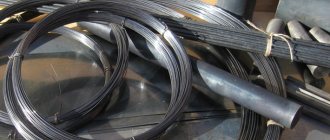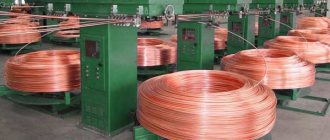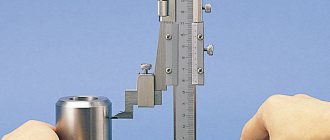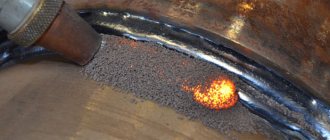GOST 3282-74
INTERSTATE STANDARD
LOW CARBON STEEL WIRE FOR GENERAL PURPOSE
TECHNICAL CONDITIONS
| Moscow Standardinform 2007 |
INTERSTATE STANDARD
| LOW CARBON STEEL WIRE FOR GENERAL PURPOSE Specifications General-purpose low-carbon steel wire. Specifications | GOST 3282-74 |
Date of introduction 07/01/75
This standard applies to round low-carbon steel wire intended for nailing, lashing, fencing and other purposes.
(Changed edition, Amendment No. 5).
TECHNICAL REQUIREMENTS
2.1. The wire must be manufactured in accordance with the requirements of this standard according to technological regulations approved in the prescribed manner, from class II wire rod according to OST-14-15-193 or other regulatory and technical documentation. It is allowed to manufacture wire from low-carbon steel grades in accordance with GOST 1050 and wire rod.
(Changed edition, Amendment No. 3, 5).
2.2. The mechanical properties of the wire must correspond to those indicated in the table. 2. At the request of the consumer, heat-treated wire is manufactured with a regulated relative elongation.
2.3. Thermally untreated wire with a diameter of 0.50 - 6.00 mm must withstand at least four bends without destruction.
(Changed edition, Amendment No. 1).
table 2
| Wire diameter, mm | Tensile strength, N/mm2 (kgf/mm2), for wire | Relative elongation d100, %, not less, for heat-treated wire | ||||
| thermally untreated | heat treated | |||||
| Group I | Group II | without cover | coated | without cover | coated | |
| From 0.16 to 0.45 incl. | 690 — 1370 | 690 — 1370 | 290 — 490 (30 — 50) | 340 — 540 (35 — 55) | 15 | 12 |
| (70 — 140) | (70 — 140) | |||||
| St. 0.45 "1.00" | 690 — 1270 | 690 — 1180 | 15 | 12 | ||
| (70 — 130) | (70 — 120) | |||||
| » 1,00 » 1,20 » | 590 — 1270 | 690 — 1180 | 15 | 12 | ||
| (60 — 130) | (70 — 120) | |||||
| » 1,20 » 2,50 » | 590 — 1180 | 690 — 980 | 15 | 12 | ||
| (60 — 120) | (70 — 100) | |||||
| » 2,50 » 3,20 » | 540 — 1080 | 640 — 930 | 20 | 18 | ||
| (55 — 110) | (65 — 95) | |||||
| » 3,20 » 3,60 » | 440 — 930 | 640 — 930 | 20 | 18 | ||
| (45 — 95) | (65 — 95) | |||||
| » 3,60 » 4,50 » | 440 — 930 | 590 — 880 | 20 | 18 | ||
| (45 — 95) | (60 — 90) | |||||
| » 4,50 » 6,00 » | 390 — 830 | 490 — 780 | 20 | 18 | ||
| (40 — 85) | (50 — 80) | |||||
| » 6,00 » 7,50 » | 390 — 830 | 490 — 780 | 20 | — | ||
| (40 — 85) | (50 — 80) | |||||
| 8,00 | 390 — 780 | 490 — 780 | 20 | — | ||
| (40 — 80) | (50 — 80) | |||||
| St. 8.00 to 10.00 | 390 — 690 | 440 — 690 | 20 | — | ||
| (40 — 70) | (45 — 70) | |||||
2.4. The surface of the uncoated wire should be free of cracks, film, dullness and scale (with the exception of heat-treated black wire).
Local rippling, dents, marks, scratches are allowed on the surface of the wire, the depth of which should not be more than a quarter of the maximum deviation of the wire of normal accuracy.
(Changed edition, Amendment No. 5).
2.5. There should be no black spots on the surface of the galvanized wire that are not coated with zinc. Individual influxes of zinc are allowed, the value of which should not be more than half the maximum deviation from the actual diameter of the wire.
Inhomogeneity of the wire in color, white spots and shine, white coating are allowed if the wire passes the coating quality test in accordance with the requirements of paragraphs. 2.6, 2.7.
(Changed edition, Amendment No. 1, 5).
2.6. The zinc coating must be durable and must not crack or peel when the wire is spirally wound onto a cylindrical core with a diameter equal to that indicated in the table. 2a.
Table 2a
| Wire diameter, mm | Ratio of core diameter to wire diameter | Number of turns, not less | |
| 1st class | 2nd class | ||
| From 0.20 to 1.60 incl. | 10 | 6 | 6 |
| St. 1.60 » 2.50 » | 8 | ||
| » 2,50 » 6,00 » | 10 | ||
Superficial dusty peeling of the zinc coating on wound samples of galvanized wire is allowed.
(Changed edition, Amendment No. 5).
2.7. The surface density of zinc, the number of dives and the duration of each dive must comply with the requirements of Table. 3.
(Changed edition, Amendment No. 1, 5).
2.8. The wire must be produced in coils or on spools. Winding of wire should be done in correct rows without interchanging the turns and ensure free winding of the wire from the spools and skeins.
The coil of wire should consist of one piece of wire. No more than three pieces of wire are allowed on reels.
(Changed edition, Amendment No. 3, 5).
Table 3
| Wire diameter, mm | Surface density of zinc, g/m2, not less | Number of dives | Duration of each dive, s | Surface density of zinc, g/m2, not less | Number of dives | Duration of each dive, s |
| Wire 1st class | Wire 2nd class | |||||
| From 0.20 to 0.32 incl. | 10 | 1 | 30 | |||
| St. 0.32 "0.40" | 15 | 1 | 30 | — | — | — |
| » 0,40 » 0,50 » | 20 | 1 | 30 | — | — | — |
| » 0,50 » 0,63 » | 30 | 1 | 60 | — | — | — |
| » 0,63 » 0,80 » | 30 | 1 | 60 | 40 | 1 | 60 |
| 0,85 | 35 | 1 | 60 | 60 | 2 | 60 |
| St. 0.85 to 1.00 incl. | 35 | 1 | 60 | 75 | 2 | 60 |
| » 1,00 » 1,20 » | 40 | 1 | 60 | 75 | 2 | 60 |
| » 1,20 » 1,60 » | 50 | 1 | 60 | 80 | 2 | 60 |
| » 1,60 » 2,00 » | 50 | 1 | 60 | 90 | 2 | 60 |
| 2,20 | 60 | 1 | 60 | 100 | 3 | 60 |
| 2,50 | 60 | 1 | 60 | 120 | 4 | 60 |
| 2,80 | 70 | 2 | 60 | 120 | 4 | 60 |
| St. 2.80 to 3.60 incl. | 70 | 2 | 60 | 135 | 4 | 60 |
| » 3,60 » 5,50 » | 80 | 3 | 60 | 155 | 4 | 60 |
| » 5,50 » 6,00 » | 85 | 3 | 60 | 155 | 4 | 60 |
2.9. The minimum weight of a coil or piece of wire on a reel must correspond to that indicated in the table. 4.
Table 4
| Wire diameter, mm | Weight of wire in a coil or on a reel, kg, not less | |
| without cover | galvanized | |
| From 0.16 to 0.18 | 1 | — |
| St. 0.20 » 0.56 | 2 | 0,3 |
| » 0,60 » 1,00 | 5 | 0,6 |
| » 1,10 » 2,00 | 8 | 2,0 |
| » 2,20 » 3,60 | 12 | 5,0 |
| » 4,00 » 6,00 | 30 | 10,0 |
| » 6,30 »10,00 | 40 | — |
Note. Uncoated wire coils with a weight 50% less than that indicated in the table are allowed. 4 in an amount of no more than 10% of the mass of wire coils in a batch.
Allowed coils of wire weighing 500 - 1500 kg. Each skein should consist of one piece of wire.
(Changed edition, Amendment No. 3, 5).
Types and main sizes
Steel wire is divided into two types: with and without zinc coating. This coating is zinc. Also, steel wire is subject to heat treatment and not. After heat treatment, the product turns out to be light and black in color. The thickness of such steel wire ranges from 0.16 mm to 10 mm.
The size range of zinc-coated products ranges from 0.2 mm to 6 mm. The coating itself is divided into two classes: first class and second class. The difference between one class and another is only in the thickness of the coating. All products of the second class have a more dense zinc coating, and therefore thicker. Products of the second class are more durable.
ACCEPTANCE RULES
3.1. Wire is accepted in batches. The batch must consist of wire of the same diameter, the same manufacturing accuracy, one type of processing, one type of surface, one class and one group and must be documented in a quality document containing:
trademark or name and trademark of the manufacturer;
wire symbol;
results of tests performed;
net weight of the batch.
(Changed edition, Amendment No. 5).
3.2. Surface quality testing is carried out on each skein or reel. The size check is carried out on 5% of the skeins or spools from the batch, but not less than on three skeins or spools.
3.3. To check the mechanical properties of the wire and the quality of the coating, 3% of the coils or coils are selected from the batch, but not less than two coils or three coils.
3.4. If unsatisfactory test results are obtained for at least one of the indicators, repeated tests are carried out on a double sample.
The results of repeated tests apply to the entire batch.
3.2 — 3.4. (Changed edition, Amendment No. 3).
Areas of application of steel wire
The use of the steel wire in question is widespread in many industries: industry, construction, agriculture. In particular, it is used:
- for the production of a wide range of hardware products (nails, self-tapping screws, fastening brackets)
- production of various shapes of fencing;
- steel wires for power transmission systems, communications;
- bundling wires and attaching them to insulators;
- in printing for stitching finished products;
- production of steel mesh for various purposes;
- in winemaking for the production of steel muzzles;
- at construction sites and house-building factories for reinforcing reinforced concrete structures;
- wire steel fiber, which allows you to eliminate cracks in concrete structures.
TEST METHODS
4.1a. For each type of test, one sample is taken from each selected coil or coil of wire.
(Introduced additionally, Amendment No. 4).
4.1. External inspection of the wire is carried out visually.
If there is a disagreement in quality assessment, the defect on the surface of the wire is removed by stripping and its depth is determined by comparative measurement of the diameter in protected and unprotected places. It is possible to determine the depth of defects using any type of microscope.
(Changed edition, Amendment No. 2, 5).
4.2. The diameter and ovality of the wire are measured in two mutually perpendicular directions of the same section in at least three places of each coil or coil with a micrometer according to GOST 6507.
The diameter of galvanized wire is measured on a section of wire with a smooth surface without sagging.
(Changed edition, Amendment No. 5).
4.3. Testing the wire for tension and rupture with a knot is carried out according to GOST 10446.
4.4. The bend test of the wire is carried out in accordance with GOST 1579. The bend test for wire with a diameter of less than 0.50 mm is replaced by a tensile test with a knot. In this case, the breaking force should not be less than 50% of the breaking force of the same wire when testing it without a knot.
Table 5
mm
| The diameter of the wire | Sample length per determination |
| From 0.20 to 1.50 | 300 |
| St. 1.50 to 3.00 | 100 |
| St. 3.00 | 50 |
4.5. Wire coiling testing is carried out according to GOST 10447.
4.6. The surface density of zinc wire is determined by the gravimetric or volumetric gasmetric method, and the uniformity and continuity of the zinc coating is determined by the immersion method.
The weight method is used for particularly precise determinations and arbitration analyses.
The length of wire samples used to determine the mass of zinc coating by gravimetric or volumetric gasometric method is indicated in table. 5.
Samples may be cut into an arbitrary number of sections depending on the test conditions.
4.6.1. Volumetric gasometric method
Removal of the zinc coating is carried out by completely immersing wire samples in the solution at ambient temperature until gas evolution stops.
A coil (coil) of wire is evaluated based on the arithmetic average of the test results of at least two samples. The test is carried out separately for each sample in the following order:
a) samples of wire are taken and the length specified for testing is measured. Samples are taken at least 0.5 m apart from each other;
b) degrease wire samples in alcohol, benzene or gasoline and wipe with a clean cloth;
c) dissolve the zinc coating, completely capturing the hydrogen released;
d) measure the volume of hydrogen released for each sample, sum it up and bring the arithmetic average to normal conditions (pressure 760 mm Hg, temperature 0 °C);
e) calculate the average surface density of zinc per 1 m2 of wire surface ( m
) in grams, according to the formula
where V
— arithmetic mean value of the volume of hydrogen under normal conditions, cm3;
d
— nominal diameter of the wire sample, mm;
l
— sample length, mm.
Zinc is bled off in an aqueous solution of a mixture of acids:
sulfur according to GOST 4204 - 100 g/dm3;
salt according to GOST 3118 - 34 g/dm3 or
in a solution of inhibited sulfuric acid prepared as follows: 2 g of Sb2O3 or As2O3 are dissolved in 60 cm3 of hydrochloric acid with a density of 1.19 g/cm3 according to GOST 3118 and added to 1 liter of sulfuric acid according to GOST 4204 with a concentration of 80 g/dm3.
The bleed solution is replaced as it becomes depleted.
4.6.2. Weight method
The amount of zinc on the surface of the wire is determined by dissolving the coating from wire samples in a solution of inhibited sulfuric acid of the composition specified in clause 4.6.1. A coil or coil of wire is evaluated by the arithmetic average of the test results.
The average mass of the coating is determined by gravimetric method in the following order:
a) samples of galvanized wire are degreased in alcohol, gasoline or benzene and wiped with a clean cloth;
b) weigh the samples;
c) dissolve the zinc coating;
d) wash the samples in distilled water and wipe with a clean cloth until moisture is removed;
e) weigh the samples and measure the actual diameter of the sample after bleeding off the zinc;
f) calculate the average surface density of zinc per 1 m2 of wire surface ( m
0), according to the formula
where m
1—weight of a wire sample (group of samples) before removing the coating, g;
m
2—weight of a wire sample (group of samples) after removing the coating, g;
d
— diameter of the wire sample after peeling off the coating, mm.
Quantities m
1 and
m
2 are determined with an error of 0.001 g, the value of
d
with an accuracy of 0.01 mm, the value of the average surface density of zinc with an accuracy of 0.1 g/m2.
(Changed edition, Amendment No. 5).
4.6.3. Immersion method
The continuity and uniformity of the zinc coating is controlled by immersing a sample of galvanized wire in a solution of copper sulfate, prepared by dissolving one part by weight of dry crystalline copper sulfate according to GOST 4165 in five parts by weight of distilled water and neutralized with an excess of freshly precipitated copper oxide hydrate. After neutralization, the solution must be filtered. The density of the neutralized filtered solution should be 1.114 - 1.116 g/cm3.
The temperature of the copper sulfate solution during the test should be (18 ± 2) °C.
The test procedure is as follows:
a) samples of wire 150 mm long are taken and washed with alcohol, gasoline or benzene. If the samples are washed with gasoline or benzene, then they are additionally washed with distilled water and wiped until moisture is removed;
b) immerse the samples in a solution of copper sulfate to a depth of at least 100 mm. The samples must be immersed for exactly 1 min. If a dive is set to 30 s, then it should be carried out after dives of 1 min. After each immersion in the solution, the samples are immediately rinsed with distilled water and wiped with a clean cloth. The number of samples simultaneously immersed in the solution should not exceed 6.
Wire samples should be in a solution of copper sulfate in a stationary state, without contacting each other or the walls of the vessel.
The number of wire samples to be tested in the same 200 ml solution of copper sulfate is given below.
Wire diameter, mm Number of samples, pcs.
From 0.20 to 0.50…………………………………….. 100
St. 0.50 » 1.00…………………………………………. 40
» 1,00 » 1,40…………………………………………. 20
» 1,40 » 2,00…………………………………………. 12
» 2,00 » 3,60…………………………………………. 6
» 3,60 » 6,00…………………………………………. 4
If, after a specified number of immersions in the solution, there are areas on the surface of the wire sample covered with copper that does not come off when wiping the sample with cotton wool or a clean cloth, then the sample is considered to have failed the test. Samples are viewed with the naked eye.
Samples are considered to have passed the test when:
a) reddening of the surface of the test wire sample in a section located at a distance of 10 mm from the level of the solution and at a distance of 20 mm from the lower end of the sample immersed in the solution;
b) a brown tint and reddening of a dotted nature, disappearing or not increasing in size and brightness with additional immersion of the sample in a solution of copper sulfate for 1 - 2 s.
(Changed edition, Amendment No. 3).
The most popular range of knitting wire
Of the variety of products produced, the most popular is the following range of tying wire:
- For the construction industry, products with a diameter of 1.2 mm and 1.4 mm. With its help, a bundle of the most common steel reinforcement 8 and 12 mm is produced.
- In printing, steel wire of 0.3 and 0.5 mm is used.
- For electrical networks, a diameter of 3 to 5 mm is used.
In each specific case, the required diameter and length of the steel wire is calculated.
5.7. (Deleted, Amendment No. 3).
5.8. Wire is transported by all types of transport in accordance with the rules for the carriage of goods in force for this type of transport.
When transported by covered transport, the weight of the cargo package should not exceed 1250 kg. The placement and securing of cargo in vehicles transported by rail must comply with the technical conditions for loading and securing cargo approved by the Ministry of Railways. Transportation by rail - by carload, low-tonnage or small shipments.
It is allowed to transport wire in universal containers in accordance with GOST 15102, GOST 20435, GOST 22225.
(Changed edition, Amendment No. 5).
5.9. Transport marking - according to GOST 14192.










